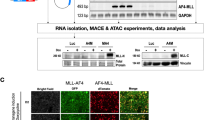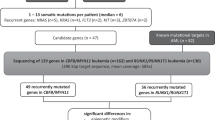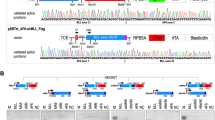Abstract
The t(10;11)(p13;q14–21) is found in T-ALL and acute myeloid leukemia and fuses CALM (Clathrin-Assembly protein-like Lymphoid-Myeloid leukaemia gene) to AF10. In order to gain insight into the transcriptional consequences of this fusion, microarray-based comparison of CALM-AF10+ vs CALM-AF10− T-ALL was performed. This analysis showed upregulation of HOXA5, HOXA9, HOXA10 and BMI1 in the CALM-AF10+ cases. Microarray results were validated by quantitative RT-PCR on an independent group of T-ALL and compared to mixed lineage leukemia-translocated acute leukemias (MLL-t AL). The overexpression of HOXA genes was associated with overexpression of its cofactor MEIS1 in CALM-AF10+ T-ALL, reaching levels of expression similar to those observed in MLL-t AL. Consequently, CALM-AF10+ T-ALL and MLL-t AL share a specific HOXA overexpression, indicating they activate common oncogenic pathways. In addition, BMI1, located close to AF10 breakpoint, was overexpressed only in CALM-AF10+ T-ALL and not in MLL-t AL. BMI1 controls cellular proliferation through suppression of the tumor suppressors encoded by the CDKN2A locus. This locus, often deleted in T-ALL, was conserved in CALM-AF10+ T-ALL. This suggests that decreased CDKN2A activity, as a result of BMI1 overexpression, contributes to leukemogenesis in CALM-AF10+ T-ALL. We propose to define a HOXA+ leukemia group composed of at least MLL-t, CALM-AF10 and HOXA-t AL, which may benefit from adapted management.
This is a preview of subscription content, access via your institution
Access options
Subscribe to this journal
Receive 12 print issues and online access
$259.00 per year
only $21.58 per issue
Buy this article
- Purchase on Springer Link
- Instant access to full article PDF
Prices may be subject to local taxes which are calculated during checkout





Similar content being viewed by others
References
Dreyling MH, Martinez-Climent JA, Zheng M, Mao J, Rowley JD, Bohlander SK . The t(10;11)(p13;q14) in the U937 cell line results in the fusion of the AF10 gene and CALM, encoding a new member of the AP-3 clathrin assembly protein family. Proc Natl Acad Sci USA 1996; 93: 4804–4809.
Dreyling MH, Schrader K, Fonatsch C, Schlegelberger B, Haase D, Schoch C et al. MLL and CALM are fused to AF10 in morphologically distinct subsets of acute leukemia with translocation t(10;11): both rearrangements are associated with a poor prognosis. Blood 1998; 91: 4662–4667.
Narita M, Shimizu K, Hayashi Y, Taki T, Taniwaki M, Hosoda F et al. Consistent detection of CALM-AF10 chimaeric transcripts in haematological malignancies with t(10;11)(p13;q14) and identification of novel transcripts. Br J Haematol 1999; 105: 928–937.
Tebar F, Bohlander SK, Sorkin A . Clathrin assembly lymphoid myeloid leukemia (CALM) protein: localization in endocytic-coated pits, interactions with clathrin, and the impact of overexpression on clathrin-mediated traffic. Mol Biol Cell 1999; 10: 2687–2702.
Klebig ML, Wall MD, Potter MD, Rowe EL, Carpenter DA, Rinchik EM . Mutations in the clathrin-assembly gene Picalm are responsible for the hematopoietic and iron metabolism abnormalities in fit1 mice. Proc Natl Acad Sci USA 2003; 100: 8360–8365.
Wechsler DS, Engstrom LD, Alexander BM, Motto DG, Roulston D . A novel chromosomal inversion at 11q23 in infant acute myeloid leukemia fuses MLL to CALM, a gene that encodes a clathrin assembly protein. Genes Chromosomes Cancer 2003; 36: 26–36.
Chaplin T, Ayton P, Bernard OA, Saha V, Della Valle V, Hillion J et al. A novel class of zinc finger/leucine zipper genes identified from the molecular cloning of the t(10;11) translocation in acute leukemia. Blood 1995; 85: 1435–1441.
Chaplin T, Bernard O, Beverloo HB, Saha V, Hagemeijer A, Berger R et al. The t(10;11) translocation in acute myeloid leukemia (M5) consistently fuses the leucine zipper motif of AF10 onto the HRX gene. Blood 1995; 86: 2073–2076.
Linder B, Newman R, Jones LK, Debernardi S, Young BD, Freemont P et al. Biochemical analyses of the AF10 protein: the extended LAP/PHD-finger mediates oligomerisation. J Mol Biol 2000; 299: 369–378.
Saha V, Chaplin T, Gregorini A, Ayton P, Young BD . The leukemia-associated-protein (LAP) domain, a cysteine-rich motif, is present in a wide range of proteins, including MLL, AF10, and MLLT6 proteins. Proc Natl Acad Sci USA 1995; 92: 9737–9741.
DiMartino JF, Ayton PM, Chen EH, Naftzger CC, Young BD, Cleary ML . The AF10 leucine zipper is required for leukemic transformation of myeloid progenitors by MLL-AF10. Blood 2002; 99: 3780–3785.
Okada Y, Feng Q, Lin Y, Jiang Q, Li Y, Coffield VM et al. hDOT1L links histone methylation to leukemogenesis. Cell 2005; 121: 167–178.
Asnafi V, Radford-Weiss I, Dastugue N, Bayle C, Leboeuf D, Charrin C et al. CALM-AF10 is a common fusion transcript in T-ALL and is specific to the TCRgammadelta lineage. Blood 2003; 102: 1000–1006.
Asnafi V, Beldjord K, Libura M, Villarese P, Millien C, Ballerini P et al. Age-related phenotypic and oncogenic differences in T-cell acute lymphoblastic leukemias may reflect thymic atrophy. Blood 2004; 104: 4173–4180.
Staal FJ, van der Burg M, Wessels LF, Barendregt BH, Baert MR, van den Burg CM et al. DNA microarrays for comparison of gene expression profiles between diagnosis and relapse in precursor-B acute lymphoblastic leukemia: choice of technique and purification influence the identification of potential diagnostic markers. Leukemia 2003; 17: 1324–1332.
Li C, Wong WH . Model-based analysis of oligonucleotide arrays: expression index computation and outlier detection. Proc Natl Acad Sci USA 2001; 98: 31–36.
Barrett T, Suzek TO, Troup DB, Wilhite SE, Ngau WC, Ledoux P et al. NCBI GEO: mining millions of expression profiles – database and tools. Nucleic Acids Res 2005; 33: D562–D566.
Beillard E, Pallisgaard N, van der Velden VH, Bi W, Dee R, van der Schoot E et al. Evaluation of candidate control genes for diagnosis and residual disease detection in leukemic patients using ‘real-time’ quantitative reverse-transcriptase polymerase chain reaction (RQ-PCR) – a Europe against cancer program. Leukemia 2003; 17: 2474–2486.
van Dongen JJ, Wolvers-Tettero IL . Analysis of immunoglobulin and T cell receptor genes. Part I: basic and technical aspects. Clin Chim Acta 1991; 198: 1–91.
Hebert J, Cayuela JM, Berkeley J, Sigaux F . Candidate tumor-suppressor genes MTS1 (p16INK4A) and MTS2 (p15INK4B) display frequent homozygous deletions in primary cells from T- but not from B-cell lineage acute lymphoblastic leukemias. Blood 1994; 84: 4038–4044.
Lee MG, Lewis SA, Wilde CD, Cowan NJ . Evolutionary history of a multigene family: an expressed human beta-tubulin gene and three processed pseudogenes. Cell 1983; 33: 477–487.
Rozovskaia T, Feinstein E, Mor O, Foa R, Blechman J, Nakamura T et al. Upregulation of Meis1 and HoxA9 in acute lymphocytic leukemias with the t(4:11) abnormality. Oncogene 2001; 20: 874–878.
Armstrong SA, Staunton JE, Silverman LB, Pieters R, den Boer ML, Minden MD et al. MLL translocations specify a distinct gene expression profile that distinguishes a unique leukemia. Nat Genet 2002; 30: 41–47.
Yeoh EJ, Ross ME, Shurtleff SA, Williams WK, Patel D, Mahfouz R et al. Classification, subtype discovery, and prediction of outcome in pediatric acute lymphoblastic leukemia by gene expression profiling. Cancer Cell 2002; 1: 133–143.
Ferrando AA, Armstrong SA, Neuberg DS, Sallan SE, Silverman LB, Korsmeyer SJ et al. Gene expression signatures in MLL-rearranged T-lineage and B-precursor acute leukemias: dominance of HOX dysregulation. Blood 2003; 102: 262–268.
Rozovskaia T, Ravid-Amir O, Tillib S, Getz G, Feinstein E, Agrawal H et al. Expression profiles of acute lymphoblastic and myeloblastic leukemias with ALL-1 rearrangements. Proc Natl Acad Sci USA 2003; 100: 7853–7858.
Zeisig BB, Milne T, Garcia-Cuellar MP, Schreiner S, Martin ME, Fuchs U et al. Hoxa9 and Meis1 are key targets for MLL-ENL-mediated cellular immortalization. Mol Cell Biol 2004; 24: 617–628.
Nakamura T, Largaespada DA, Shaughnessy Jr JD, Jenkins NA, Copeland NG . Cooperative activation of Hoxa and Pbx1-related genes in murine myeloid leukaemias. Nat Genet 1996; 12: 149–153.
Lawrence HJ, Rozenfeld S, Cruz C, Matsukuma K, Kwong A, Komuves L et al. Frequent co-expression of the HOXA9 and MEIS1 homeobox genes in human myeloid leukemias. Leukemia 1999; 13: 1993–1999.
Park IK, Qian D, Kiel M, Becker MW, Pihalja M, Weissman IL et al. Bmi-1 is required for maintenance of adult self-renewing haematopoietic stem cells. Nature 2003; 423: 302–305.
Lessard J, Sauvageau G . Bmi-1 determines the proliferative capacity of normal and leukaemic stem cells. Nature 2003; 423: 255–260.
Jacobs JJ, Kieboom K, Marino S, DePinho RA, van Lohuizen M . The oncogene and Polycomb-group gene bmi-1 regulates cell proliferation and senescence through the ink4a locus. Nature 1999; 397: 164–168.
Cayuela JM, Madani A, Sanhes L, Stern MH, Sigaux F . Multiple tumor-suppressor gene 1 inactivation is the most frequent genetic alteration in T-cell acute lymphoblastic leukemia. Blood 1996; 87: 2180–2186.
Abate-Shen C . Deregulated homeobox gene expression in cancer: cause or consequence? Nat Rev Cancer 2002; 2: 777–785.
Lawrence HJ, Helgason CD, Sauvageau G, Fong S, Izon DJ, Humphries RK et al. Mice bearing a targeted interruption of the homeobox gene HOXA9 have defects in myeloid, erythroid, and lymphoid hematopoiesis. Blood 1997; 89: 1922–1930.
Izon DJ, Rozenfeld S, Fong ST, Komuves L, Largman C, Lawrence HJ . Loss of function of the homeobox gene Hoxa-9 perturbs early T-cell development and induces apoptosis in primitive thymocytes. Blood 1998; 92: 383–393.
Kroon E, Krosl J, Thorsteinsdottir U, Baban S, Buchberg AM, Sauvageau G . Hoxa9 transforms primary bone marrow cells through specific collaboration with Meis1a but not Pbx1b. EMBO J 1998; 17: 3714–3725.
Thorsteinsdottir U, Mamo A, Kroon E, Jerome L, Bijl J, Lawrence HJ et al. Overexpression of the myeloid leukemia-associated Hoxa9 gene in bone marrow cells induces stem cell expansion. Blood 2002; 99: 121–129.
Ayton PM, Cleary ML . Transformation of myeloid progenitors by MLL oncoproteins is dependent on Hoxa7 and Hoxa9. Genes Dev 2003; 17: 2298–2307.
Nakamura T, Mori T, Tada S, Krajewski W, Rozovskaia T, Wassell R et al. ALL-1 is a histone methyltransferase that assembles a supercomplex of proteins involved in transcriptional regulation. Mol Cell 2002; 10: 1119–1128.
Milne TA, Briggs SD, Brock HW, Martin ME, Gibbs D, Allis CD et al. MLL targets SET domain methyltransferase activity to Hox gene promoters. Mol Cell 2002; 10: 1107–1117.
Martin ME, Milne TA, Bloyer S, Galoian K, Shen W, Gibbs D et al. Dimerization of MLL fusion proteins immortalizes hematopoietic cells. Cancer Cell 2003; 4: 197–207.
Speleman F, Cauwelier B, Dastugue N, Cools J, Verhasselt B, Poppe B et al. A new recurrent inversion, inv(7)(p15q34), leads to transcriptional activation of HOXA10 and HOXA11 in a subset of T-cell acute lymphoblastic leukemias. Leukemia 2005; 19: 358–366.
Soulier J, Clappier E, Cayuela JM, Regnault A, Garcia-Pedro M, Dombret H et al. HOXA genes are included in genetic and biological networks defining human acute T-cell leukemia (T-ALL). Blood 2005; 106: 274–286.
Nakamura T, Largaespada DA, Lee MP, Johnson LA, Ohyashiki K, Toyama K et al. Fusion of the nucleoporin gene NUP98 to HOXA9 by the chromosome translocation t(7;11)(p15;p15) in human myeloid leukaemia. Nat Genet 1996; 12: 154–158.
Borrow J, Shearman AM, Stanton Jr VP, Becher R, Collins T, Williams AJ et al. The t(7;11)(p15;p15) translocation in acute myeloid leukaemia fuses the genes for nucleoporin NUP98 and class I homeoprotein HOXA9. Nat Genet 1996; 12: 159–167.
Owens BM, Hawley RG . HOX and non-HOX homeobox genes in leukemic hematopoiesis. Stem Cells 2002; 20: 364–379.
Shen WF, Rozenfeld S, Kwong A, Kom ves LG, Lawrence HJ, Largman C . HOXA9 forms triple complexes with PBX2 and MEIS1 in myeloid cells. Mol Cell Biol 1999; 19: 3051–3061.
Fujino T, Yamazaki Y, Largaespada DA, Jenkins NA, Copeland NG, Hirokawa K et al. Inhibition of myeloid differentiation by Hoxa9, Hoxb8, and Meis homeobox genes. Exp Hematol 2001; 29: 856–863.
Thorsteinsdottir U, Sauvageau G, Hough MR, Dragowska W, Lansdorp PM, Lawrence HJ et al. Overexpression of HOXA10 in murine hematopoietic cells perturbs both myeloid and lymphoid differentiation and leads to acute myeloid leukemia. Mol Cell Biol 1997; 17: 495–505.
Bjornsson JM, Andersson E, Lundstrom P, Larsson N, Xu X, Repetowska E et al. Proliferation of primitive myeloid progenitors can be reversibly induced by HOXA10. Blood 2001; 98: 3301–3308.
Haupt Y, Bath ML, Harris AW, Adams JM . bmi-1 transgene induces lymphomas and collaborates with myc in tumorigenesis. Oncogene 1993; 8: 3161–3164.
Iwama A, Oguro H, Negishi M, Kato Y, Morita Y, Tsukui H et al. Enhanced self-renewal of hematopoietic stem cells mediated by the polycomb gene product Bmi-1. Immunity 2004; 21: 843–851.
Rabbitts TH . Chromosomal translocation master genes, mouse models and experimental therapeutics. Oncogene 2001; 20: 5763–5777.
Beverloo HB, Le Coniat M, Wijsman J, Lillington DM, Bernard O, de Klein A et al. Breakpoint heterogeneity in t(10;11) translocation in AML-M4/M5 resulting in fusion of AF10 and MLL is resolved by fluorescent in situ hybridization analysis. Cancer Res 1995; 55: 4220–4224.
Angioni A, La Starza R, Mecucci C, Sprovieri T, Matteucci C, De Rossi G et al. Interstitial insertion of AF10 into the ALL1 gene in a case of infant acute lymphoblastic leukemia. Cancer Genet Cytogenet 1998; 107: 107–110.
Chaplin T, Jones L, Debernardi S, Hill AS, Lillington DM, Young BD . Molecular analysis of the genomic inversion and insertion of AF10 into MLL suggests a single-step event. Genes Chromosomes Cancer 2001; 30: 175–180.
Van Limbergen H, Poppe B, Janssens A, De Bock R, De Paepe A, Noens L et al. Molecular cytogenetic analysis of 10;11 rearrangements in acute myeloid leukemia. Leukemia 2002; 16: 344–351.
Klaus M, Schnittger S, Haferlach T, Dreyling M, Hiddemann W, Schoch C . Cytogenetics, fluorescence in situ hybridization, and reverse transcriptase polymerase chain reaction are necessary to clarify the various mechanisms leading to an MLL-AF10 fusion in acute myelocytic leukemia with 10;11 rearrangement. Cancer Genet Cytogenet 2003; 144: 36–43.
Acknowledgements
ED is supported by Fondation de France, Comité Leucémie, l'Association de Recherche contre le Cancer et la Ligue Nationale contre le Cancer, comité de Paris. WAD, JJMvD and AWL are supported by the Dutch Cancer Foundation (EMCR 2002-2707), AWL is supported in part by the Haak Bastiaanse Kuneman Foundation. We thank Dr Frank JT Staal from the Department of Immunology, Erasmus MC, Rotterdam, for technical advice on microarray analysis, Dr Jean-Philippe Jais from the Department of Biostatistics, Hôpital Necker-Enfants-Malades, for statistical support, Dr Jean-Michel Cayuela from the Laboratory of Hematology, Hôpital Saint-Louis, Paris, for the gift of CDKN2A probe and Pr Ali Saad from the Laboratory of Cytogenetics, Farhat Hached hospital, Sousse, Tunisia, for valuable help.
Author information
Authors and Affiliations
Corresponding author
Additional information
Supplementary Information
Supplementary Information accompanies the paper on the Leukemia website (http://www.nature.com/leu).
Supplementary information
Rights and permissions
About this article
Cite this article
Dik, W., Brahim, W., Braun, C. et al. CALM-AF10+ T-ALL expression profiles are characterized by overexpression of HOXA and BMI1 oncogenes. Leukemia 19, 1948–1957 (2005). https://doi.org/10.1038/sj.leu.2403891
Received:
Accepted:
Published:
Issue Date:
DOI: https://doi.org/10.1038/sj.leu.2403891
Keywords
This article is cited by
-
Acute myeloid leukemia with rare recurring translocations—an overview of the entities included in the international consensus classification
Annals of Hematology (2024)
-
Clinico-biological features of T-cell acute lymphoblastic leukemia with fusion proteins
Blood Cancer Journal (2022)
-
Fusion of the CRM1 nuclear export receptor to AF10 causes leukemia and transcriptional activation of HOXA genes
Leukemia (2021)
-
Therapeutic implications of menin inhibition in acute leukemias
Leukemia (2021)
-
Synthetic modeling reveals HOXB genes are critical for the initiation and maintenance of human leukemia
Nature Communications (2019)



